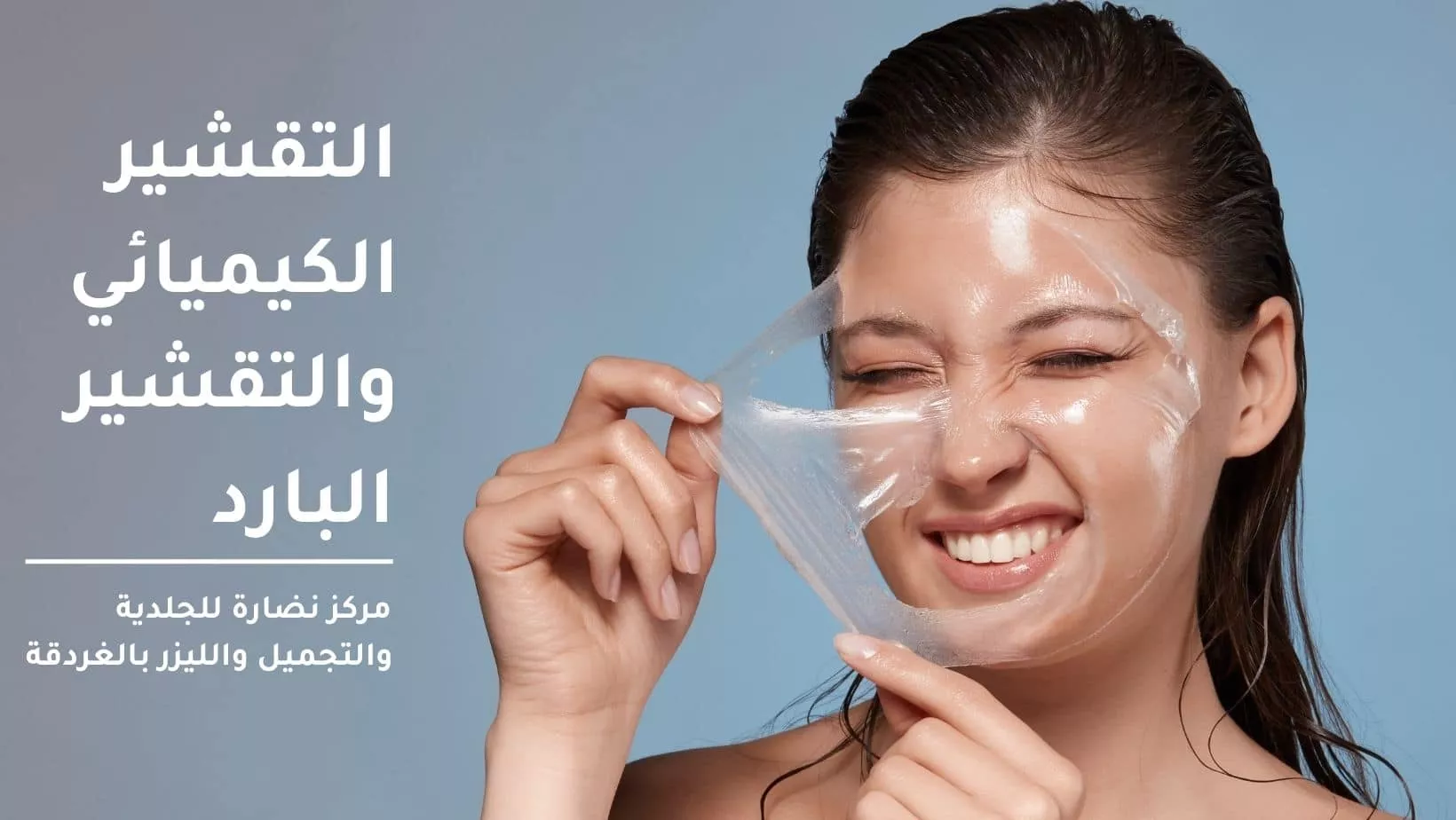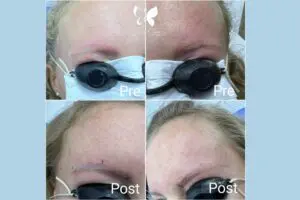Chemical peels and cold peels help rejuvenate the skin and provide0 lasting anti-aging results.
Both work to provide fresher, younger and healthier skin for many years.
nadara Center for Dermatology, Cosmetic and Laser in Hurghada offers these modern techniques for skin peeling without undergoing surgical intervention.
You can continue reading this article to learn more about chemical peels and cold peels and which one is right for you?
What is a chemical peel?
Known as a chemical solution applied to the skin such as glycolic, salicylic and lactic acids, it will give you a brighter skin.
This type of exfoliation works by losing the upper layers of the skin, and the new skin is usually smoother with fewer lines and wrinkles.
How does a chemical peel work?
Chemical peels and cold peels should be performed in a specialized medical center such as the Nadara Center in Hurghada.
The skin is thoroughly cleansed to remove excess oils, then the doctor protects your eyes and hair and applies the exfoliating solution to the skin.
Multiple types of chemicals penetrate to different depths of the skin, then peel off to reveal a new layer of skin.
You may feel a slight warmth or heat on your skin and this feeling lasts for a few minutes.
You can apply cold compresses to the skin to relieve this feeling.
Types of chemical peels
The types of chemical peels and cold peels differ from each other, and the types of chemical peels include the following:
Mild chemical peel
This option may be best if you have fine wrinkles, rough skin, or sun-damaged skin.
Recovery time for this type of peeling takes within hours to a few days, but with little or no time to rest.
Medium Chemical Peel
It gives the skin a smooth and refreshed appearance as the outer layer and the top middle layer of the skin can be removed.
Use if skin tone is uneven or moderate, and you suffer from age spots, or light to medium wrinkles.
Recovery time may take up to a week or more, and may require some time to rest.
deep chemical peel
This type of exfoliation gives more accurate results as this chemical penetrates the lower middle layer of the skin.
It takes longer to heal as it treats moderate lines and wrinkles, severely sun damaged skin, and deep acne scars.
A deep peel requires up to 8 weeks of pretreatment, but is a one-time treatment if applied correctly to the face.
You can also read : New skin with gold stamp | The latest skin rejuvenation technology.
Benefits of a chemical peel
Chemical peels are used to treat certain skin conditions or to improve your appearance by improving skin tone and texture.
It can most commonly be applied to the face, neck or hands as it helps with the following:
- Treating fine lines under your eyes or around the mouth, wrinkles caused by sun damage, and some genetic factors.
- Eliminate freckles and uneven skin tone.
- Eliminate precancerous scaly patches called Actinic keratosis.
- Treating rough skin, dull skin patches, or dark spots (melasma) due to pregnancy or taking birth control pills.
You and your dermatologist in nadara clinic will work out the depth of the peel, and the number of sessions varies depending on the skin condition and treatment goals.
Sagging, puffiness, deep scars, and severe wrinkles do not respond to chemical peels and cold peels if you delay treatment.
Instructions before performing a chemical peel
General guidelines for preparing the skin for chemical peels and cold peels include:
- Avoid tanning products and direct sun exposure for two weeks before each treatment.
- You can use topical creams such as hydroquinone .
- Do not use any products that contain retinoids (such as tretinoin) 1 to 2 weeks before treatment.
- If the doctor recommends oral antibiotics or antivirals, they should be taken at least 24 hours before the start of the sessions.
- Exfoliation areas should be free of any open sores, lesions, or skin infections.
- You can apply a anesthetic cream before sessions to reduce any pain or discomfort.
You can also read : chin Laser hair removal | Is it painful?
Chemical peeling results
What you can expect varies depending on the depth of the peel, and the following results appear:
Mild chemical peel
- Expect a sunburn-like reaction after the peel, which means you will see redness followed by peeling that lasts 3 to 7 days.
- Apply lotion or cream as directed until the skin has healed, then you can apply sunscreen daily.
- You can apply cosmetics and make-up immediately after the treatment or the next day.
- Additional peeling can be repeated every two to five weeks until you achieve the desired results, and usually 3 to 5 sessions are required.
Medium Chemical Peel
- Expect some redness and swelling that lasts for 24 hours, and blisters may develop and peel off of the skin within 7 to 14 days.
- Use a moisturizing ointment on the face, and do not expose it to the sun until it is completely healed.
- Antivirals should be taken for 10 to 14 days.
- You can apply makeup after 5 to 7 days.
- You can repeat the peel every 6 to 12 months if necessary.
deep chemical peel
- The dermatologist at the nadara Center in Hurghada puts medical dressings on the treatment site, then removes them within days, and the recovery time is from 14 to 21 days.
- Do not expose your skin to the sun for 3 to 6 months.
- Wait at least 14 days before using any makeup.
- You can only do one deep peeling on your face.
Chemical peel side effects
Some types of skin may experience a permanent or temporary change in color, such as:
- Cases taking birth control pills.
- Having a family history of discoloration on the face.
These conditions can be at greater risk of developing abnormal pigmentation.
If you have a history of herpes infection, there is little chance of a reactivation cold sore.
Your doctor may recommend medication to reduce the chance of reinfection.
Also, be sure to tell him or her if you've had an overgrowth of scar tissue at the treatment site or had unusual scarring because an infection has not occurred.
You can also read : Botox injection areas and its benefits for the skin.
What is a cold peel?
It is one of the latest medical technologies that regenerate the surface of the skin from the first layer of the skin to the second layer.
It uses special types of creams to remove the outer layer of the skin and stimulate the growth of collagen to get a more youthful skin.
Benefits of a cold peel
The benefits of chemical peels and cold peels vary, as the cold type contributes to the following:
- Skin Tightening.
- Fine lines reductions.
- Minimizing skin pores.
- Reduce wrinkles and smile lines.
- Reduce age spots.
- Improve skin texture.
- Post-inflammatory hyperpigmentation treatment.
Cold peeling is distinguished from other peeling treatments in that it provides great results to the skin through its cooling feature and prevents the effect of prolonged heat.
The patient does not feel any pain or discomfort after the sessions, and the recovery time is very short.
Types of cold peeling
There are two types of cold peeling:
- Cosmelan peeling.
- Dermamelan peeling.
Both types use the same treatment protocol but Dermamelan contains 30% higher ingredients.
Both types feature specific combinations of active acidic ingredients and vitamin nutrients, but do not contain skin whitening agents.
You can also read : The dangers of obsessing over beauty products.
Cold peeling steps
The dermatologist at the Dermatology Center in Hurghada carefully examines the skin to determine your suitability for the treatment.
One session takes 45 to 60 minutes, as it begins with cleansing the skin and preparing it to get rid of excess oils.
The doctor applies a thin layer of the Cosmelan and Dermamelan face mask evenly over the entire face and not just the pigmented areas.
It stays on the face for 8 to 12 hours depending on the skin type, so it is best to use it in the morning.
Then follow the instructions on when and how to remove the mask, as well as the home care kit for permanent depigmentation results.
It can also be used to treat areas of the body that easily suffer from sun damage such as the arms, chest, and shoulders where dark spots and freckles are located.
How does cold peel work?
Cosmelan works by inhibiting the enzyme tyrosinase responsible for the production of melanin in the skin through both corrective and preventive actions.
corrective actions
This process reduces the formation of melanin, stimulates cell renewal, and intensively combats its accumulation in the surface layer of the skin to fade unwanted pigmentation.
preventive actions
It reduces the function of the enzyme tyrosinase, which prevents melanin from reaching the surface of the skin.
Dermamelan works similar to the Cosmelan procedure but contains active ingredients that are effective in treating more severe skin pigmentation problems such as:
- severe cutaneous melasma;
- acne scars
Cold peeling results
You may experience mild side effects such as redness or peeling, but they will gradually go away on their own.
Cosmetics can be used one day after treatment without any problems.
The peeling effect usually begins within two to three days after the procedure, and is often accompanied by itching.
Applying the aftercare regimen helps soothe the skin.
The pigmentation begins to fade gradually and the skin becomes brighter and more lustrous after just one week of treatment.
The application of sunscreen is one of the most important instructions that should be followed after the sessions, which leads to maintaining the results.
You can also read : Getting rid of birthmarks with laser and the reasons for their appearance.
Frequently asked questions about chemical peels and cold peels
What is the difference between chemical peeling and cold peeling?
A chemical peel uses a chemical solution applied to the skin to rejuvenate and improve its appearance, while a cold peel uses a cream to treat some skin problems.
Which is better chemical peeling or cold peeling?
Both types offer great results in reducing skin damage and revealing healthy skin, but they serve different purposes, and have different types and instructions.
We recommend making an appointment to consult a dermatologist at nadara Center for Dermatology, Cosmetic and Laser in Hurghada to evaluate the skin and determine the appropriate type of peeling.
Is cold peeling safe for the skin?
Yes, as it does not require surgical intervention and does not require anesthesia, in addition to that it does not contain lightening agents, which makes it suitable for all skin types.
However, it is not suitable for pregnant women, or people who have an active skin infection, or are allergic to any of the ingredients.







